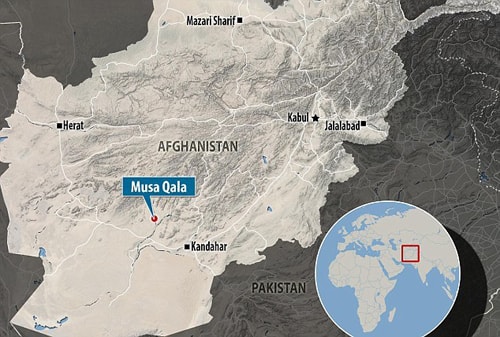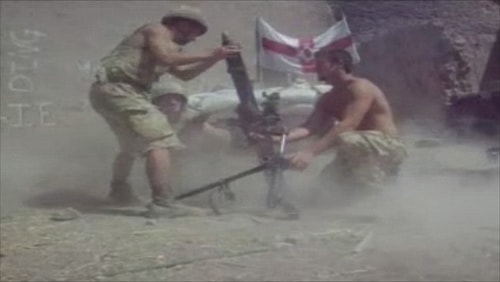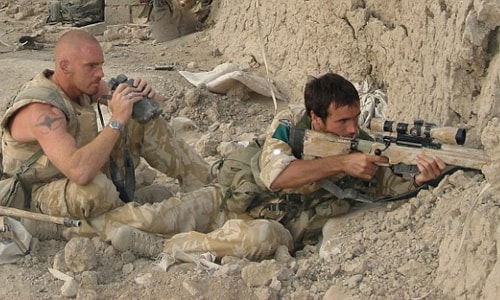British paratroopers and 56 days in the Taliban siege
Recently, the channelChannel 4Britain has made an elaborate documentary about a company of British paratroopers who fought to the death amid a siege of about 500 Taliban insurgents in Afghanistan 10 years ago.
The battle began on August 23, 2006, when the 88-member British Royal Army Parachute Company E was dropped by Chinook helicopters at Musa Qala base in Helmand province, Afghanistan, to replace the Danish garrison of the NATO coalition maintaining security in this remote area.
Danish soldiers fight the Taliban at Musa Qala base
It seems that the Taliban in the area were happy to see the Danish troops leave with more than 40 armored vehicles, 8 heavy machine guns and 12 medical teams equipped with armored ambulances. The E Company that came to replace them had only two heavy machine guns, a doctor, two medics and a 4-wheel drive vehicle.
Worse, shoulder-fired rocket-propelled grenades were constantly lurking around the villages surrounding the base, making helicopter gunfire support extremely dangerous, while reinforcements were never sent, for unknown reasons.When Taliban spies reported a reduction in armor and heavy firepower inside the Musa Qala base, the insurgent leaders seemed to sense an easy victory.
Soon after, Staff Sergeant Ian Wornham, while monitoring Taliban radio communications, picked up disturbing messages. "They were talking about having tea in our headquarters at sunrise, meaning they would kill anyone in their path," Wornham recounted.
An even worse outcome for the British soldiers stationed there was being captured alive by the rebels, and running the risk of being beheaded, videotaped and posted on YouTube. “There was a point where I was close to breaking down. I would have preferred to have been hit by a mortar. I remember standing in the base, my legs shaking,” said sniper Jared Cleary.
The Taliban mobilized hundreds of gunmen to attack the base. Initially, the rebels applied frontal assault tactics, charging in waves, aiming to capture the base as quickly as possible.
 |
Musa Qala is located in a remote area of Helmand province, southern Afghanistan. Graphic: AFP |
At one point, the rebels were so close to the base that they were able to hurl grenades over the walls. "I've never been in a battle like that. It was extremely intense, and not from one direction. They were coming from all sides, all the time," said Wornham, who has been in the war for 20 years.
"You have to return fire, but as one goes down, another appears, and you wonder how many more are going to come," said Sergeant Freddie Kruyer. "They're not normal enemies. So I thought, 'I'll save myself one last shot if they overrun the base.'"
The British soldiers' chances of survival inside this rudimentary base were slim. "We were completely alone. The base could easily have been lost completely," recalled Paratrooper Major Adam Jowett, commander of E Company.
Fight to the end
Suffering heavy casualties from Groves' accurate mortar fire, the Taliban changed tactics, beginning long-range attacks with mortars, rockets, and sniper fire, causing E Company to suffer its first casualties.
 |
Mortar battery commanded by Corporal Groves at Musa Qala base. Photo: C4 |
A rebel sniper bullet hit a gap in the body armor of Signal Corporal Jon Hetherington, killing him instantly on August 27. "He was standing right next to me on the roof of the command post," Jowett said, recalling the moment his subordinate was hit.
However, they had no time to mourn. "It was strange, we knew he was dead, but we also knew he would be okay and we would get him out of Musa Qala. We continued to take up positions and fight," the major said.
"At first we all thought why did Jon have to die. But we had to get over it, and we couldn't stop or hide in a corner. We had to fight them, it was in our blood as paratroopers," Wornham asserted.
Less than a week later, a rebel mortar shell hit the observation post of two other soldiers in the company, killing one on the spot and seriously injuring the other, who died shortly thereafter.
Food supplies were running low, and E Company prepared for the worst, but was determined to fight to the end. The Taliban responded with a barrage of rocket and mortar fire. As the British paratroopers climbed onto rooftops to look out and snipe, they nodded to each other as if it were the last time they would see each other.
By September 11, the Taliban had received reinforcements and ammunition, bringing the total number of fighters participating in the attack to 500, and the fate of Musa Qala seemed sealed. Both sides were ready for a final all-out assault.
 |
Two snipers of E Company protect Musa Qala base. Photo: C4 |
At that moment, an unexpected development occurred. The elders of the area, having seen their villages destroyed during nearly two months of fierce fighting, persuaded the rebels to cease fire. They arranged for Major Jowett to leave the base and meet with the rebel leader to discuss ways to end the bloodshed.
After negotiations, the Taliban agreed to withdraw, and Company E remained at the Musa Qala base for another month, before elders arranged for their safe withdrawal in a convoy of cattle trucks to rendezvous with two Chinook helicopters on October 14.
The Battle of Musa Qala was over. E Company had fought relentlessly for 56 days, expending a quarter of the ammunition used by the entire British force in Afghanistan in a year. Ten years later, in February 2016, the Taliban retook the small town from the Afghan army.
According to VNE
| RELATED NEWS |
|---|

